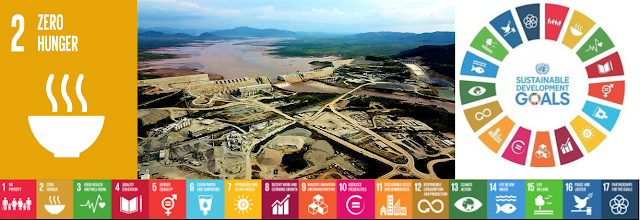GERD: Ending Child Undernourishment and Hunger
The Grand Ethiopian Renaissance Dam and Sustainable
Development Goals
On
the 25th September 2015 at the United Nations summit on sustainable
development, the world adopted a historical document titled “Transforming Our World: the
2030 Agenda for Sustainable Development.” The agenda is a plan of action
for people, planet and prosperity and consists of
17 sustainable development goals of most urgent priority to the international
community.
Amongst
the SDGs, Goal 7 on Energy has been recognised as an enabler for achieving
almost all of the Sustainable Development Goals, “from the eradication of
poverty through advancements in health, education, water supply and
industrialisation, to combating climate change.” Thus, failure to
avail reliable, sustainable, and affordable energy supply means that
sustainable development grinds to a halt - and subsistence itself becomes uncertain.
This part of GERD-SDG series attempts to show how the Grand Ethiopian
Renaissance Dam enables Ethiopia, Sudan, and Egypt to achieving sustainable
development goals. In this piece, we will attempt to show how GERD contributes
to the achievement of Zero Hunger in North-Eastern Africa.
Today, more than 820 million people regularly
go to bed hungry due to human-made conflicts, climate change,
and poverty. The COVID-19 pandemic could now
double that number, putting an additional 130 million people at risk of suffering acute
hunger by the end of 2020. Hunger in Sub-Saharan Africa is prevalent, with 237 million undernourished
people in 2017.
The paper uses the Global
Hunger Index (GHI) to measure and track hunger level in
North-Eastern Africa. GHI is calculated using a three-step process that draws
on available data from various sources to capture the multidimensional nature
of hunger. First, for each country, values are determined for four indicators:
undernourishment, child wasting, child stunting, and child mortality. Accordingly,
all countries, save for Egypt, are suffering from severe hunger. These
countries score as follows: Egypt - 14.6, Sudan – 32.8, Ethiopia – 28.9, and Kenya – 25.2.
The region needs to end hunger and achieve food security through
sustainable agriculture. In this regard, the role of dams and energy in the
provision of water for irrigation and power
to irrigate, dry, mill, pasture, and cook food is indispensable.
Energy also holds the key to the successful realisation of “Zero Hunger.”
The Grand Ethiopian Renaissance Dam will:
1. Ensure the much-needed expansion of irrigation scheme in the region;
2. Ensure a regulated flow of Nile waters that keep the water levels of
irrigation canals in Sudan that made
possible irrigation agriculture with minimum energy consumption; and
3. Put additional energy into the Sudanese grid system for irrigation
purposes in the region.
GERD: Electrifying Poverty Eradication
These region needs a reliable, sustainable, and affordable energy supply to eradicate poverty because energy is “the master resource” for development! The Grand Ethiopian Renaissance Dam, with its installed capacity of over 5000MW of electric power, will contribute significantly to ensuring the much sought after access to energy for North-Eastern Africa. Thus, GERD can play a significant role in ensuring that millions of children go to bed with something decent in their stomach.






Comments
Post a Comment